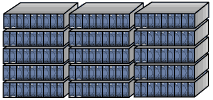 |
  MyData raises the bar on how Web sites
are hosted. MyData raises the bar on how Web sites
are hosted.
Our hosting platform features the redundancy and
backup found only at top-level, commercial data centers. Mydata is capable
of distributing various areas and functions of your Web site across
multiple servers; each one manages a different application for optimum
performance. Other hosting companies run numerous applications on
one server, thus increasing the likelihood of failure.
MyData lets you focus on your business, not your Web site's uptime.
 Our system features intelligent Cisco Catalyst Switches, Network
Appliance Raid 10 Filers and on-line backup machines with additional
disc drives, ensuring that your data will always be available. Even
in an extreme case, if one part of our hosting network was to go
down, your Web site will continue to operate without loss of any
data or prolonged downtime. Our system features intelligent Cisco Catalyst Switches, Network
Appliance Raid 10 Filers and on-line backup machines with additional
disc drives, ensuring that your data will always be available. Even
in an extreme case, if one part of our hosting network was to go
down, your Web site will continue to operate without loss of any
data or prolonged downtime.
We also employ clustering technology to ensure that our network
has optimal performance and is scalable, as well as redundant. For
instance, we have an extremely robust mail system that utilizes
high-performance Linux servers that tie into an EMC
enterprise storage system on the back-end to provide high-end intelligent
mail services. This includes the latest in spam and virus protection
software, configurable through advanced controls available to you,
our customer, through Command Console. MyData
also has dedicated mySQL servers that are configured with performance-optimized
redundant RAID 10 SCSI storage for a best-in-class solution.
On top of our redundant architecture sits the Command Console. The
WHM/Cpanel Console puts you in control of the server cluster by allowing
you to seamlessly modify entries and settings on DNS, e-mail
or file serving clusters.
Our primary equipment is hosted at our main Data Center, located
in US,
which serves as a major hub for telecommunication providers on a
global basis. Power is conditioned, monitored and backed up by UPS
and diesel generators. Our multi Tier-1 bandwidth providers include Mzima
Networks, which operates over private peering networks to avoid
overcrowded public exchanges.
|
|
 |

